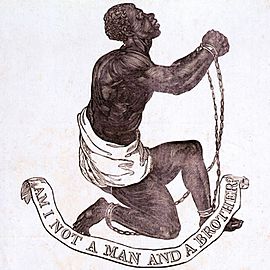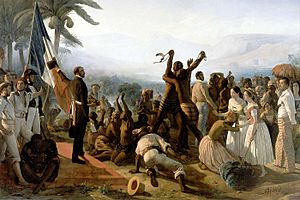Abolitionism facts for kids
Abolitionism was a big movement that wanted to completely end slavery. This movement was mainly active in Europe and the Americas during the 1700s and 1800s. For a long time, most people didn't speak out against slavery. But then, thinkers from the Enlightenment period started to say that slavery was wrong. They believed it went against basic human rights. Also, groups like the Quakers felt that slavery did not follow the teachings of Christianity.
Contents
Slavery in the United States
Before the United States was formed, slavery existed in many parts of the world. The word "slave" actually comes from the "Slavs," a group of people who were often enslaved in the past. In British North America, slavery was used to help the economic system, especially in the southern colonies.
Indentured Servants and Slaves
The first people brought to the Thirteen Colonies were often indentured servants. These people were not slaves. They worked for a limited time, usually about seven years. After their service, they were given land and money. They were used for manual labor, similar to slaves.
Over time, it became less profitable for landowners in the south to hire indentured servants. By the early 1700s, the enslavement of Africans became more common. Unlike indentured servants, enslaved Africans were treated as property for their entire lives.
Early Opposition to Slavery
For a long time, there was not much opposition to slavery in the colonies. Only a few groups spoke out against it. These included Quakers, freed slaves, and enslaved people themselves.
The American Revolution and Slavery
During the American Revolutionary War, which started in 1775, the British governor of Virginia, Lord Dunmore, made a promise. He said that enslaved people and indentured servants who fought for the British would gain their freedom. This promise only applied to those held by the rebelling colonists. Many enslaved people joined the British side. Sadly, many of them died from disease, not in battle. When the war ended, Lord Dunmore did not keep his promise. Most enslaved people who fought with the British were returned to slavery. Some black Loyalists were taken to Canada or other places.
The American Army also had many black soldiers, especially from New England. The 1st Rhode Island Regiment was a famous group. It was created in 1778 and was mostly made up of black men. Their commander, Colonel Christopher Greene, promised freedom to any enslaved person who joined.
After the U.S. Constitution was written, most black people remained enslaved. Slavery started to decrease in some areas. Most northern states made slavery illegal shortly after the Revolution. In the south, tobacco, which was the main crop, was losing value. However, in 1794, Eli Whitney invented the cotton gin. This machine made it much faster to process cotton. This invention made cotton farming much more profitable, which unfortunately led to an increase in the demand for enslaved labor in the South.
Haitian Revolution
Before the Haitian Revolution in 1791, about 90% of the people on the island of Hispaniola were enslaved. When the French Revolution happened, it issued the Declaration of the Rights of Man and of the Citizen. This declaration stated that all people had certain rights. The enslaved people on the island felt these rights should apply to everyone, not just white slave owners. This belief helped spark their fight for freedom.
Interesting Facts About Abolitionism

- To abolish something means to completely get rid of it.
- In the United States, abolitionism specifically meant ending slavery.
- Slavery was most common in the southern parts of what became the United States.
- The first people used for forced labor were often indentured servants.
- Indentured servants usually worked for about 7 years. After that, they were given land and money for their service.
- In the early 1700s, Africans began to be used as slaves. They were kept as property for their entire lives, and this practice became widely accepted.
- By the 1800s, more and more people started speaking out against slavery and wanted to abolish it.
Notable Abolitionists
Many brave people, both white and black, fought against slavery. This list includes some formerly enslaved people who became important leaders in the movement.
- William Wilberforce – He was a leader of the abolitionist movement in England. He was a politician who worked hard to end slavery and discrimination.
- Toussaint Louverture
- Abbé Grégoire
- James Mill
- Jeremy Bentham
- John Stuart Mill
- Harriet Martineau
- Harriet Tubman
- John Brown
- Harriet Beecher Stowe
- John Gregg Fee
- Isabel, Princess Imperial of Brazil
- John Laurens
- William Lloyd Garrison
- José do Patrocínio
- Frederick Douglass
- Henry David Thoreau
- Oren Burbank Cheney
- John Woolman
- Charles Miner
- Joaquim Nabuco
- David Walker
- Nat Turner
- Sarah Mapps Douglass
- William Wells Brown
- Ellen and William Craft
- Frances Ellen Watkins Harper
- Henry Highland Garnet
- Sojourner Truth
- John Quincy Adams
- Angelina and Sarah Grimké
Images for kids
-
The Chevalier de Saint-Georges, known as the "Black Mozart", was an important figure for free black people due to his social position and political involvement.
-
Jacques Pierre Brissot (1754–1793) helped create the Society of the Friends of the Blacks in 1788.
-
Lord Mansfield (1705–1793) made a ruling in Somerset's Case (1772) that many believed meant slavery was not legal in England.
-
Olaudah Equiano was a free African living in Britain. He was active in the movement to end the slave trade in the 1780s.
-
The painting of the 1840 Anti-Slavery Convention at Exeter Hall.
-
William Wilberforce (1759–1833) was a politician and generous person who led the movement to abolish the slave trade.
-
Thomas Clarkson was a key speaker at the first conference of the British and Foreign Anti-Slavery Society (now Anti-Slavery International) in London, 1840.
-
Chief Justice Thomas Andrew Lumisden Strange helped free Black Nova Scotian slaves.
-
Uncle Tom's Cabin was a book that made many people in the North and Britain angry about the terrible things about slavery.
-
Black volunteer soldiers leaving service to start their new freedom, shown in Harper's Weekly, 1866.
-
José Gregorio Monagas ended slavery in Venezuela in 1854.
-
A statue on Kunta Kinteh Island, The Gambia, remembering the end of the Atlantic slave trade. The stick figure is a Kanaga mask.
See also
 In Spanish: Abolicionismo de la esclavitud para niños
In Spanish: Abolicionismo de la esclavitud para niños















